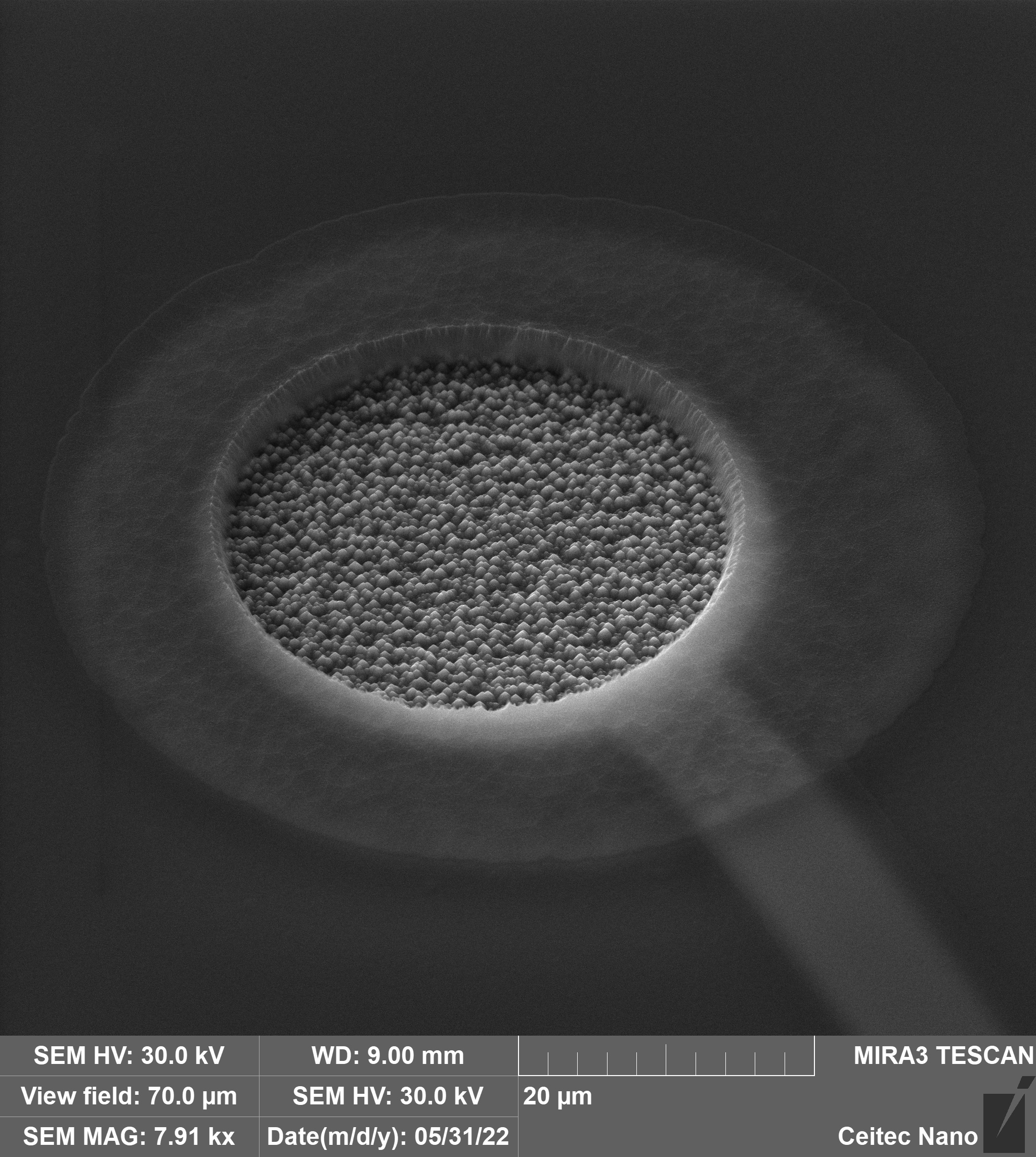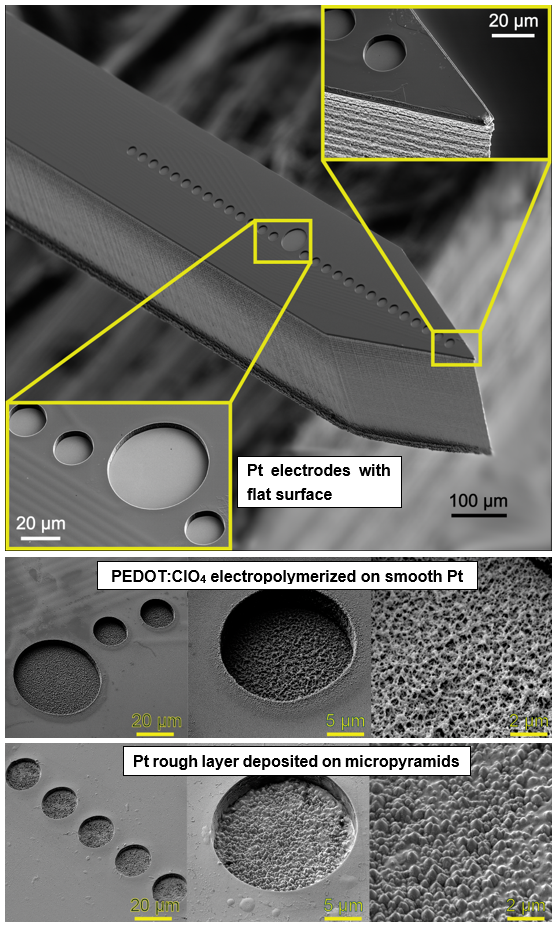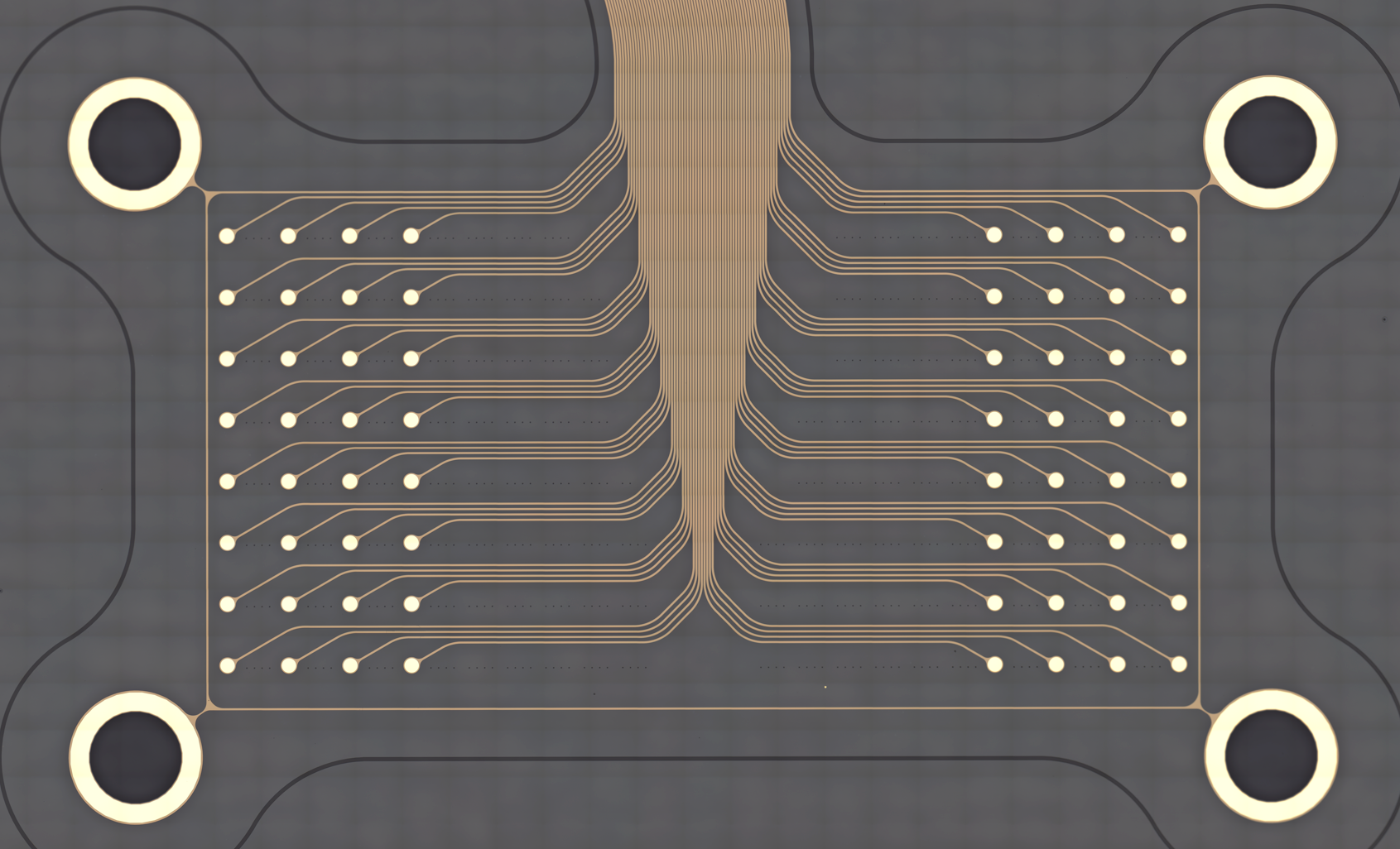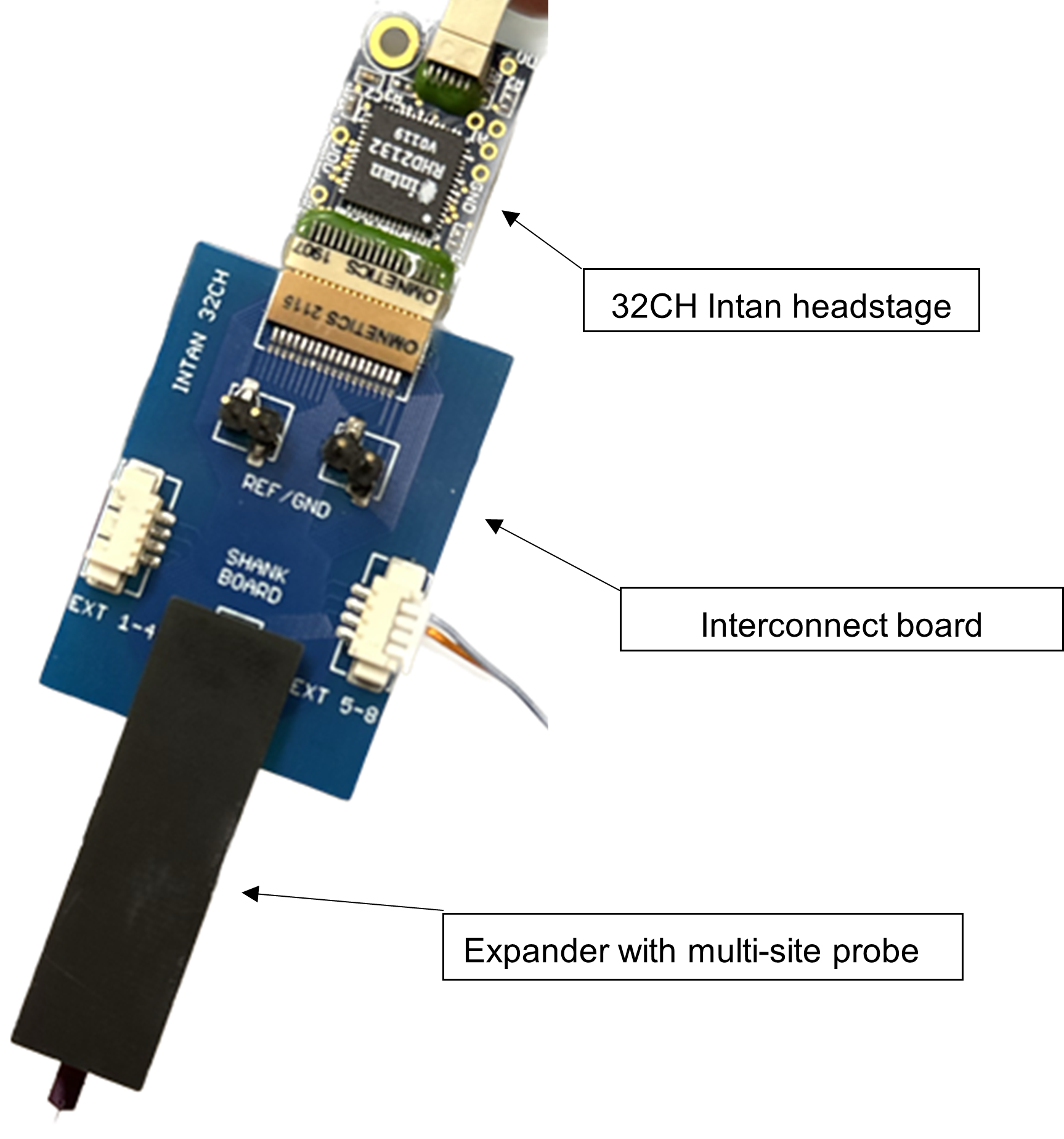Bioelectronics Fabrication - BioEl Fab ( contact: glowacki@vutbr.cz for inquiries and pricing info)
The Bioelectronics Materials and Devices group provides custom design, engineering, consulting, microfabrication, measurement, and testing services for external academic and commercial partners. We can prvide affordable and professional services with fast turn-around time and are happy to discuss custom projects. The following represents our "standard" offers:
Multi-site probe electrodes
We can offer fabrication of Michigan-type probes on request with large variety of parameters, which will ensure the optimal usage for intended application. This type of device is made on etched Si or SOI (silicon-on-insulator) wafers with durable combination of inorganic and polyimide/parylene passivation/encapsulation on the side with electrodes. It could be also possible to prepare double sided probes with structures on both sides on request. Our portfolio includes several types of electrode materials such as Au, Pt, TiN, or PEDOT formulations, and many others. Full list of parameters is written in the following table. Since there is an infinite number of variants, it is not possible to mention them all, but we should be able to fulfill your ideas if they will be in accordance with our design rules listed in the table below while the scheme of single shaft probe is represented picture below.
|
Number of shafts (Nshafts) |
≥ 1 |
|
Shaft length (Lshaft) |
30 mm ≥ Lshaft ≥ 50 µm |
|
Shaft gap (Lgaps) |
≥ 30 µm |
|
Electrode diameter (Del) |
≥ 5 µm |
|
Electrode gap (Lgapel) |
≥ 3 µm |
|
First electrode on tip position (Loffset) |
≥ 50 µm |
|
Number of electrodes per shaft (Nel) |
maximum = Lshaft/(Del+Lgapel) |
|
Shaft width (Wshaft) |
5 mm ≥ Wshaft ≥ (Nel−1) × 3 + Del + 20 |
|
Body extension (Lbodyext) |
(30 mm − Lshaft) ≥ Lbodyext ≥ 0 µm |
|
Electrode material |
Au, Pt, TiN, C (doped with B), DLC, electropolymerized PEDOT with various counter-ions, spin-coated PEDOT:PSS |
|
Electrode configuration |
Straight, ZigZag |
|
Thickness (tprobe) |
1000 µm ≥ tprobe ≥ 30 µm |
|
Pads layout for connection |
Wire-bonding (Au/Al) or Glue (conductive epoxy) to PCB (flex or FR-4) |
|
Connectors on carrier PCB |
Optional – on request (Mezzanine/Array Connectors, ZIF, OMNETICS, etc…) |



Macro and Microelectrode arrays
We offer fabrication of flexible devices for acute and chronic experiments in large scale variety of dimensions and number of electrodes, using parylene-c or polyimide as the substrate and encapsulation material. Such devices are suitable for flexibel nerve cuffs or ECoG arrays, for example. Our "flagship" flexible device platform is based on ultrathin Polyimide reinforced with ceramic nitride layers, and high-quality sputtered conductive and passivation layers using ion-beam sources which possesses extraordinary electrical and mechanical properties and reproducibility contrary to other PVD methods. Thus, these devices are able to provide the best performance over long time. Electrode materials for neural interfaces are the same as are mentioned in multi-site electrode probes description (Au, Pt, TiN, PEDOT, etc.). We can also provide combination of different electrode materials on one structure. The best electrical connection of these devices is provided by FFC/FPC connectors but also other methods like gluing or wire-bonding are possible if required.


Assembly options, custom PCBs
We offer assembling of fabricated bioelectronics to carrier substrates according to customer requests. We are fully equipped with technologies for design and fabrication printed circuit boards (PCBs) and thick film technology. We can provide mounting on flexible (polyimide or polytetrafluorethylene) and rigid carrier substrates (FR-4, aluminum, copper or alumina in case of thick film technology). We can also offer mounting of surface mount technology (SMT) and through hole technology (THT) connectors (FFC/FPC zif, Omnetics, Molex, pin headers, etc.) on requested substrates, with short turn-around time in most cases. Mounting of fabricated bioelectronics on carrier substrates and its mounting with connectors will be carefully discussed with customer to meet criteria for connection to intended system.
Rigid connections
We offer standardized mounting of device on FR-4 substrate which is the cheapest option but is mostly sufficient for acute experiments or for experiments, where the rigidity of substrate and its dimensions does not play a role. On the other hand, if necessary, we can also embed the chip into LCC or PLCC packages, where chip is mechanically fixed by glue and electrically connected by wire-bonding, which is the most expensive variant. The typical mounting and electrical connections of fabricated bioelectronic devices relies on gluing and eventually wire-bonding which depends on type of the device and customer request. The typical example is our multi-site electrode glued to the FR-4 carrier substrate and electrical connection is provided by wire-bonding method using gold wire while the connection to the rest of the system is provided by board-to-board connector.
Flexible connections
This option is preferred for chronic experiments, where the movement and weight of the board can be a problem. This connection can be provided in similar way to rigid connection, but the board is flexible and low-weight, hence, the device is usually mounted and connected to one end of PCB, while the second end is connected through the connector to other part of electrical system.
Compatibility with standard electronics
We will provide custom-made realization of your project which will perfectly fit intended system in terms of dimensions and electrical connection. We are able to prepare devices and boards compatible with different systems, and have the most experience with Intan and MCS compatibility.
One general example chip connection for Intan system is shown in following picture, probe connection to external devices. Chip is glued on the black expander PCB which contains ENIG finished Au pads and an array connector (40 CH). Electrical contacting was done by a wire-bonding method. Black PCB is connected through the array connector to the blue interconnect PCB which is equipped with 1 × 36 CH Omnetics connector for the Intan headstage (including 2 × REF and 2 × GND contacts) and 2 × 4 CH Molex connectors for other external electrical devices. If such external devices are not needed on the probe, the blue interconnect PCB could be significantly miniaturized.


We can also provide fabrication of interconnect boards, which will fit commercial systems and will be equipped with additional connectors for external electronics.



